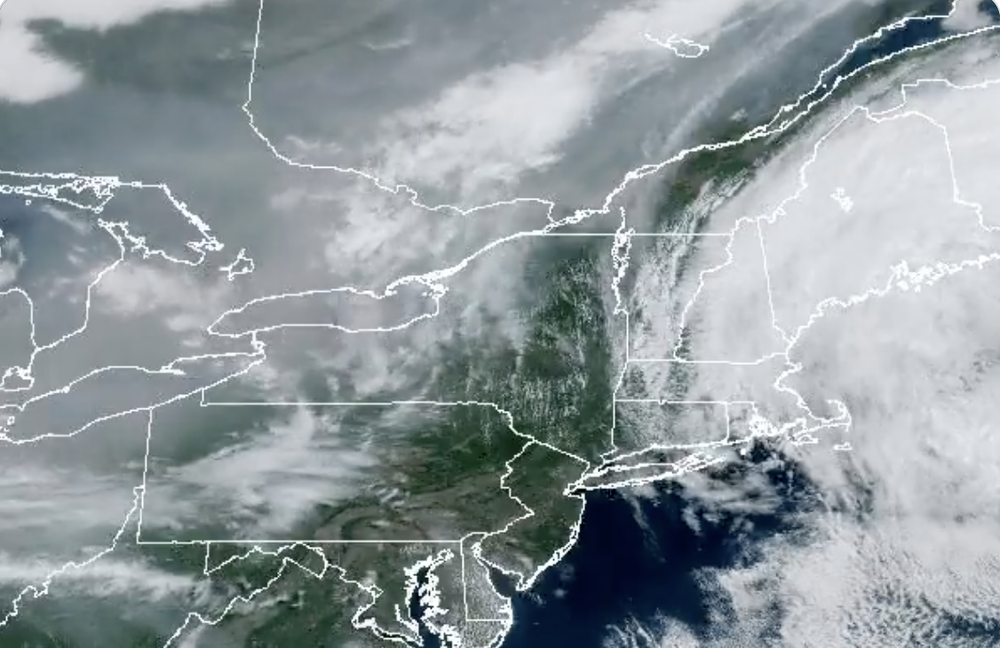Smoke from wildfires in Canada continues to afflict NYC's air quality
June 5, 2023, 4:07 p.m.
Smoke is coming from Quebec, where more than 100 wildfires are still burning, affecting the city’s air quality.

New York still can’t catch its breath.
Last week, smoke from a massive fire in the Canadian province of Nova Scotia worsened air quality levels from New York City to Washington, D.C. Now, the smoke is coming from Quebec, where more than 100 wildfires are still burning, affecting the city’s air quality.
The New York State Department of Environmental Conservation initially issued air quality health alerts for the Adirondacks, Eastern Lake Ontario, Central New York and Western New York Monday from 10 a.m. through 11:59 p.m. due to concerns about levels of fine particulate matter in the air due to the smoke.
On Tuesday, as the smoke reached the downstate area, the National Weather Service issued an air quality alert for Manhattan, the Bronx, Brooklyn, Queens, Staten Island, as well as Nassau, Suffolk, Westchester, Rockland, Orange, and Putnam counties, through midnight.
Here is the latest Satellite imagery this am. You can see the smoke and haze (north and west of our area) from the wild fires burning over Quebec. The smoke and haze is expected to move over the area this evening and overnight and continue into Tuesday. pic.twitter.com/3rAuQ7C7sc
— NWS New York NY (@NWSNewYorkNY) June 5, 2023
Air quality in the New York City region has ebbed and flowed since the Canadian wildfires began last week.
Meteorologist John Homenuk, who runs the New York Metro Weather Twitter account, said air quality levels Monday night and into Tuesday are expected to get worse as the smoke overhead mixes down close to the surface — but they will not be as bad as last week.
“It could be pretty hazy out there, and the smoke could be pretty noticeable on Tuesday afternoon and evening,” Homenuk said. “But for [Monday night], I think it's mostly elevated, [Tuesday] morning it's mostly elevated. It's really Tuesday afternoon for a period of time, for a couple hours that it could mix down, close to the surface and be really noticeable as it comes through.”
Particulate matter, namely pieces smaller than 2.5 microns, can be breathed deep into the lungs and go by the term “PM2.5.” Short-term exposure irritates the eyes and respiratory tract, leading to shortness of breath — while prolonged experiences can worsen asthma and heart disease.
The DEC urged New Yorkers to do what they can to conserve energy and reduce pollution as the smoke goes over the area — such as using mass transit, turning off lights in unoccupied areas and using fans to circulate air.
The National Weather Service said conditions could be hazardous to all populations in the city and the EPA recommends people avoid strenuous outdoor activities or consider moving them inside.
“Just take some precautionary steps to make sure that you're not overexerting yourself, putting yourself in a situation where you can be impacted negatively by it, knowing that the air quality is definitely degraded compared to usual,” Homenuk said.
Nsikan Akpan contributed reporting.
This story has been updated with comment from meteorologist John Homenuk and to reflect a new air quality alert for downstate New York.
The air is bad and 'very unhealthy.' But relief is coming for NY and NJ.